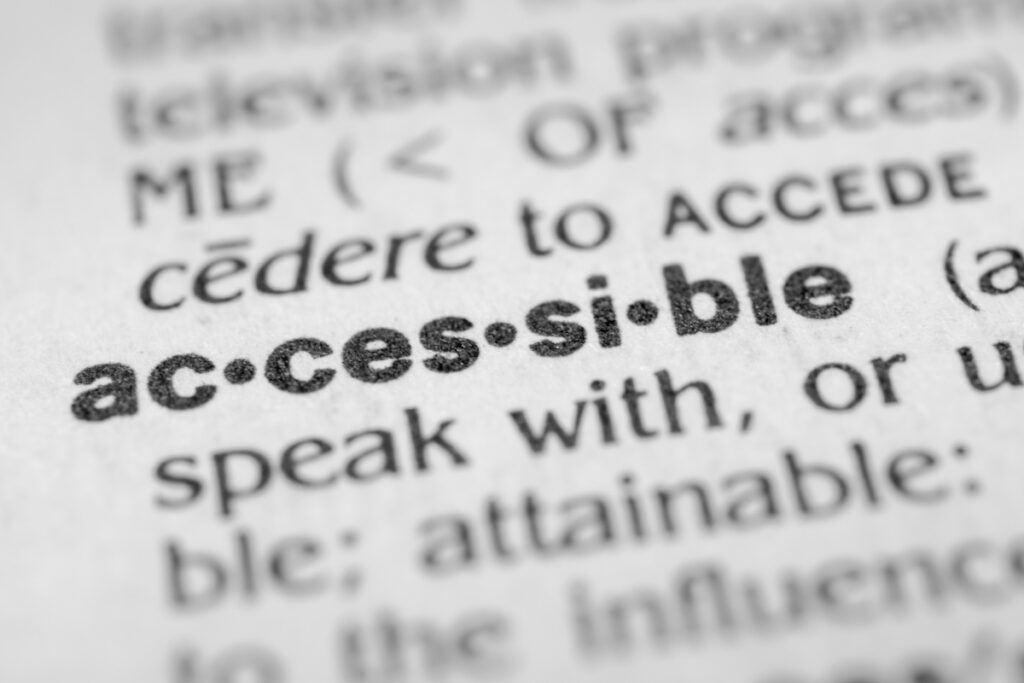As a copywriter or creative, you may be tasked with creating alt text (or alternative text) for images that appear in the digital content that you make. Having a good understanding of how alt text is used will help you to make your work more accessible. Here are some best practices for creating text descriptions.
What is Alt Text?
Image text alternatives explain a picture, illustration, or chart through web page markup. People who are blind or low vision can use a screen reader like JAWS, which reads text on the web to them. People with slow internet connections may turn off images to load pages faster, showing the text description of the image instead. Also, people with cognitive or learning disabilities may elect to read text descriptions of images for better comprehension.
Complying with Web Content Accessibility Guidelines affirms the right of people with disabilities to be able to navigate the web freely and independently. While the average reading speed for an adult is around 300 words per minute, a person accustomed to using a screen reader may process text as fast as 500 wpm (like speeding up a podcast). Without image descriptions, even if the image isn’t necessary to comprehend the page, the screen reader sometimes reads an error. This creates confusion or frustration because the site is not fully accessible to the user.
If an image has a function, such as a donate button or to click somewhere, without alt text, the user will be lost. They might not be able to make a purchase, to fill out a form, or to understand an important piece of information. It’s worth mentioning that W3C WAI guidelines say that if an image is decorative, it should simply have null alt (alt=””). But many people in the disability community and their allies add a short description regardless.
Context is Everything
People who use screen readers — like sighted people — scan a page of text. That’s why it’s so important to use properly formatted headers, so the reader can jump from one section to another. Other navigation tools ensure that the reader doesn’t get stuck in a navigation trap or endlessly scrolling through a page. When an image conveys information about what is being discussed, tabbing through image descriptions can help the person using a screen reader to understand the content of the page or article. Or it may be necessary to advance within the page.
The first step to writing better alt text is to understand the context for which the image is being used. Often an image is intended simply to break up large blocks of text on a page but is related to the subject. It may not be crucial to understanding the meaning of the text, or it can show something mentioned in the text for emphasis. Keep descriptions short. A simple alt text like “woman seated at desk, using computer” is enough. Cut unnecessary words: you don’t have to write “image of” or “link” because the screen reader provides that information.
Many people attempt to describe an image in greater detail, such as: “white woman wearing blue and white striped shirt seated at desk, working on computer and smiling.” In this case, think about the purpose of the image and whether the color of her skin or shirt is critical to comprehend the page. Some graphic designers, photographers, or art directors, who rely more on visual information, can get bogged down in the details of an image. But it’s not necessary to describe every detail unless it adds value to the reader’s understanding of the image and the content of the story.
If an image is essential for understanding the content of the story, clearly explain what it depicts. For example: “people at rally holding signs saying ‘xyz’” or “empty shelves of coronavirus tests.”
Shorter is Better. Usually.
Shannon Finnegan (they/them) is an artist who examines disability in their multidisciplinary work. With artwork constantly being shared on websites and in social media, Finnegan became curious about accessibility and exploring the questions that come up as we try to describe images. With collaborator and fellow disabled artist, Bojana Coklyat, they teach workshops on “Alt Text as Poetry.”
If a picture is worth a thousand words, well, it seems that “sighted people have a tendency to over describe,” Finnegan confirms. Perhaps it’s because they’re constantly engaging with and categorizing visual information. Or maybe they’re concerned about making a mistake. But usually a concise description is better, saving the reader time and conveying the significance of the image without describing every detail.
It Should Match the Tone of the Piece
Finnegan interrogates subjectivity in the alt text workshops. They believe that when possible, there should be a “unified perspective or voice” in digital content. It can be confusing if a piece is confessional and the images are described in an objective way. In a first person piece, it might make sense to even use slang or jargon in a description.
Finnegan points out that it is also a choice to have a very technical description of an image. It’s not neutral, and something is lost when the feeling of an image isn’t conveyed.
It is also possible to be more transparent in image descriptions. If an image is being used to convey a point, the description could use less authoritative words. It can demonstrate that the image is being interpreted: “seems to show,” “can be,” etc.
Don’t Forget about Complex Images
Many people forget or avoid including alt text when it’s far more challenging. Social media graphics with long pull quotes or charts with lots of detail are complicated. Meaning is being conveyed through images with text or through data visualization. In these examples, it is necessary to explain the information in greater detail.
The DIAGRAM Center has extensive resources and training tools for how to describe more complex images, like flow charts, maps, and diagrams. If you are a creative who regularly designs infographics or charts, it’s worthwhile to check out their slide decks.
Another challenge is describing people. There can be value judgements ascribed when mentioning a facial expression or gesture. Some people think that it is best to omit descriptions of race or ethnicity entirely. Others think that it can be more direct to describe skin tone, physical characteristics, or body type. Sometimes it may also be important for the client to show that the images include a specific population.
Gender identity and expression is another challenge. The writer may assume that they know the identity of the person pictured. Where possible, Finnegan suggests, ask people to provide the image description for their own headshot or portrait. That enables them to share any personal preferences they may have about language and identity.
We make assumptions and categorize people all the time visually. This becomes even more apparent when thinking about describing an image for alt text. The complexity of visual information can be overwhelming at times, but that leads to the next point.
It Doesn’t Have to Be Perfect
Many people worry about getting it right when they need to create alt text. But omitting a description altogether is far worse than an imperfect description. Practice helps. Discuss standards or tone for image descriptions for a particular project in advance. Include them in a style guide. It’s helpful to think about why you’re making the choices that you’re making and to understand that they are, in fact, choices.
These are “interesting and complicated questions,” Finnegan believes, adding that we can all “practice together.”
With more lawsuits opposing lack of equal access and a greater awareness of accessibility in general, writing good alt text is not just “a nice thing to do.” It ensures that people with disabilities have the same access to information as everyone else.
About the author.
Jess Powers writes about marketing, food, and wellness. She has experience in nonprofit communications and emergency management. Follow her @foodandfury.




